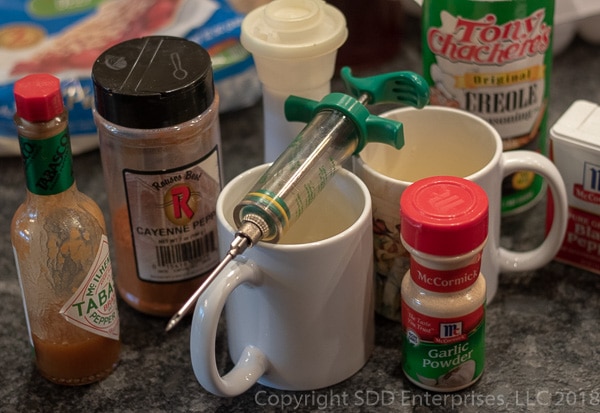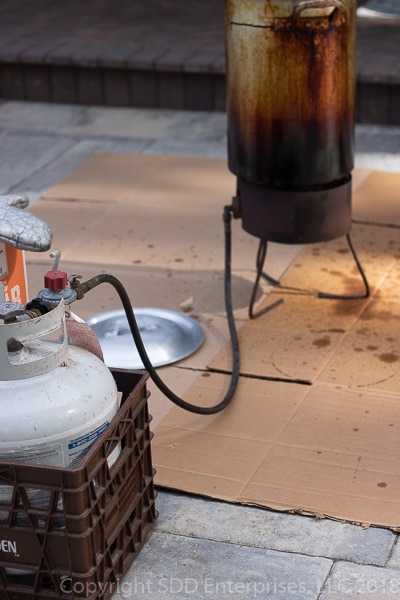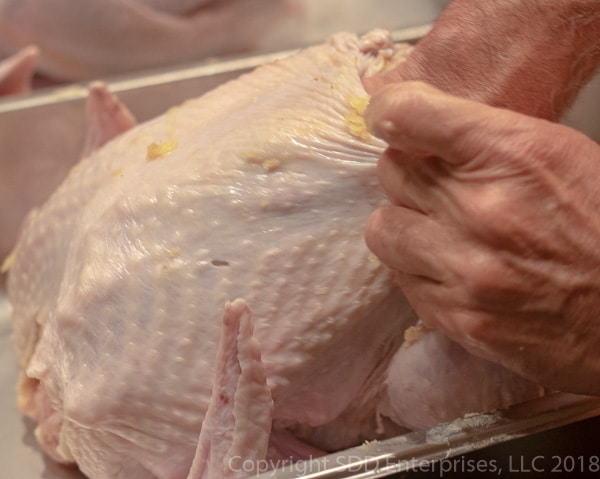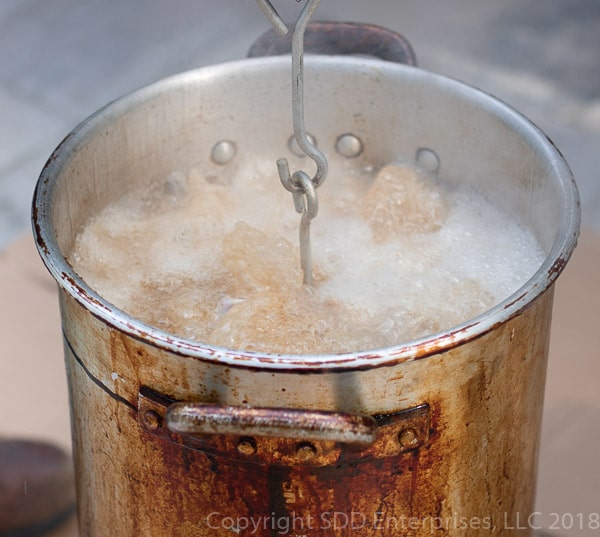Cajun Fried Turkey...an absolute treat. Injected and rubbed with Cajun seasoning, then deep fried. The result is crispy skin and moist and tasty meat mixed with all those Cajun spices-phenomenal flavor and it's done a lot quicker then roasting in the oven.

This post is not sponsored, but you will find affiliate links on this page. The price you pay as a consumer does not change, but I may make a small commission based on your purchase.
Sign up for my email notifications of new recipes and posts right HERE.
Fried turkey was inevitable in South Louisiana. With the development of portable propane and butane “boiling rigs” used to boil crawfish, it was only a matter of time before it evolved to other uses. A couple of Cajuns standing around drinking beer and boiling crawfish just naturally thought it may be a good idea to use the burner to fry up some shrimp, fish and oysters, so special pots were developed to fry things. Then the fry pot got a little bigger and before long whole turkeys were being fried. Like most things culinary in South Louisiana, it caught the attention of the nation and soon it was a thing...a very special thing. Many men in South Louisiana are great cooks and just don’t brag about it, like my friend, Berto. He’s been frying turkeys for years and has it down to a science. I was lucky enough to be invited to help out on his latest turkey fry...I learned a lot, drank a few beers and enjoyed some great fried turkey! Here’s what I learned.
Here’s What You Need
Turkey and Seasonings
To get huge flavor, we’ll make an injection and a rub with some simple ingredients. Both the injection and the rub will use these basic ingredients: ground black pepper, salt, garlic powder and creole seasoning. The injection is butter-based, so in addition to these basic ingredients add butter, cayenne pepper and Tabasco hot sauce. The injection ingredients need to be as fine as possible to get through the injector needle, so use some fine ground pepper. For the rub, add Hungarian paprika to the base ingredients. Of course, these can be varied according to your personal tastes and what you have available. The bird should be a 12 to 14 pound fresh or frozen turkey. Don’t go much bigger than that because it will be harder to handle in the fryer and may cause a safety issue-if you need a bigger bird, consider frying more than one. You’ll need about 3 gallons of oil. Peanut or canola oil is recommended, but you can use frying oil or vegetable oil, or get in touch with your inner-Cajun and use Lard.

Equipment
I’m sure there are a few ways to configure a rig to fry the turkey, but it's important that your equipment is suited for high temperature frying and stable to deal with a bulky bird, relative to the size of the fryer. You’ll need a butane or propane burner and a turkey fryer like this 30 Quart rig from Bayou Classic. It will come with a heavy duty aluminum stockpot and a turkey rack and hook for handling the turkey. The tall and narrow design will also save oil, which can be expensive. See the Hints and Tips on conserving oil. Make sure you have some insulated gloves. A fully charged fire extinguisher that is rated to handle grease fires is a handy tool to have. You also need some thermometers. I recommend an infrared thermometer to quickly check the oil temperature, a probe thermometer that can be left in the fryer and an instant read thermometer to check the bird for doneness. You’ll also need a meat flavor injector. The best thing about all these toys is that they are reusable, so once you have collected them, you’re good to go whenever you feel like some Cajun Fried Turkey. I have some recommendations at the end of this article for the things you should have in your turkey frying arsenal.

Sign up for my email notifications of new recipes and posts right HERE.
Here’s What You Do
First...you have a beer. Before we get started, I have to point out that this particular undertaking comes with some pretty serious safety concerns. First, pop the cap on a beer and sit down and read completely through, not only the recipe, but the safety tips as well. The frying process takes a little time and you likely will have a couple of beers, but please be mindful-you need to have your faculties about you when undertaking this. The ingredients for this are pretty simple, but the hardest part of your mise en place is making sure you have the right equipment set up properly.
Mix the Spices and Prepare the turkey
If using a frozen turkey, be sure to safely thaw it according to these instructions. Make sure there is no ice lodged inside the cavity even after it has defrosted. The fresh or defrosted turkey should be taken out of the refrigerator about 2 hours before frying so that its not extremely cold when it hits the oil. Remove the giblets and neck and reserve those for another use. Rinse the turkey in cold water and pat dry with paper towels, inside and out.
Combine all the ingredients for the rub in a small bowl and set it aside. Melt the butter for the injection mix, then add all the other injection ingredients to the butter and mix well. Don’t get all anal about the exact measurements but make sure you have at least a stick of butter for each turkey. If you like it hotter, add more cayenne or hot sauce.

Fill the flavor injector syringe with the injection mix and inject it into the turkey in several places on all sides. Make sure to get under the wings and legs. It will get a little messy so spread any dripped injection mixture all over the turkey using your hands. Check out the Hints and Tips for a useful tip on injecting.

Sprinkle some of the rub mix inside the cavity and rub in with your hand. Separate the skin from the flesh by sliding your fingers under the skin to loosen, then place some rub under the skin with your fingers.

Apply the remainder of the rub all over the outside of the bird on all sides. Set the turkey aside to rest for at least an hour or as much as overnight in the fridge.

Sign up for my email notifications of new recipes and posts right HERE.
Set up the fryer
It's very important that you read through the Safety Tips or the Recipe Notes before you go any further. People have burned themselves severely and burned down their homes by being careless and that's not necessary.
While the turkey is enjoying its rub-a-dub-dub, set the burner and propane tank on a level surface, preferable concrete or grass, then set the frying stockpot on the burner and make sure it is stable.

Configure it so that you will not have to step over the burner hose and possibly trip or knock it over. Before adding the oil, read the Tip on how to determine how much oil you need. Add the proper amount of oil to the stock pot-probably three (3) gallons of frying oil, clip your thermometer to the side of the stockpot, light the burner and adjust the flame to medium-high. The frying temperature will be 350 degrees, but heat the oil to 375 degrees to help compensate for the drop in temperature for when you put the turkey in.
Turkey in the fryer
Place the turkey on the turkey rack according to the manufacturer's recommendation.

When the oil reaches 375 degrees, it's time to add the turkey. Turn off the burner, then using the turkey rack and hook, SLOWLY lower the turkey into the heated oil until it is completely submerged.

The oil will go crazy at first when the colder bird is placed in it, but when it calms down, re-light the burner and place the cover on the pot. This will help the temperature rise to about 350 degrees quicker. Adjust the burner to maintain the oil at approximately 350 degrees.

The turkey will take about 3 minutes per pound-for a 12 to 14 pound bird, that's 36 to 42 minutes. When removing the turkey from the fryer, turn off the burner first, then SLOWLY lift straight up on the handle of the turkey rack by the hook in-this is much easier and safer if you have some help. Hold the rack over the fryer until the oil has dripped off.

While holding the turkey over the fryer, have someone insert an instant read thermometer into the thigh to check the internal temperature. The turkey is done when the internal temperature is 165-170 degrees in the thigh. In order not to overcook and get a dry bird, remove it from the fryer when the internal temperature of the thigh is about 160 degrees. The carry-over heat (the heat in the bird will continue to cook it after it is removed from the cooker) will bring the internal temperature to 165 to 170 degrees-perfection. If done, place the entire rack on a pan. Set the turkey aside in a pan to rest and let any excess oil drip off.
Here's what the US Department of Agriculture says:
A whole turkey is safe when cooked to a minimum internal temperature of 165 °F as measured with a food thermometer. Check the internal temperature in the innermost part of the thigh and wing and the thickest part of the breast. For reasons of personal preference, consumers may choose to cook turkey to higher temperatures.
That’s it, all there is to it, simple as that.

Safety Tips
Warning: this can be a very dangerous undertaking that can result in serious burns and/or burning down your deck or your house. It has happened! Please observe these safety precautions:
Do this outside! Not inside.
Set up on a clean, clear and level surface-preferably concrete or grass. Do not do this on a wooden deck.
Use the proper equipment:
- A heavy aluminum 30 quart stock pot (at leas,t but you can use whatever size fits your situation) designed for frying-i.e., tall and narrow.
- Proper turkey rack and hook for lowering and raising the turkey into the oil.
DO NOT OVERFILL THE STOCKPOT WITH OIL. Fires and severe burns will occur if the oil overflows when you lower the turkey into the stockpot. The first concern is that the turkey will displace the oil in the fryer, so it needs somewhere to go. Next, when the cold turkey hits the oil, the oil will go crazy. The oil WILL overflow if you put the turkey in too fast or if you have too much oil in the stockpot. Once the oil overflows, it hits the flame and then...trouble. I can’t overemphasize this too much.
The fryer stockpot should have a maximum fill line marked on it, but still exercise extreme caution not to overfill the pot.
One way to determine the amount of oil required is to place the turkey in the pot and add water until it is just over the bird by about ½ inch. Slowly remove the turkey and all the water drain back into the pot. Mark where the water fill line is and use that as a guide to fill the oil. Dry the pot and the turkey completely with paper towels. Even when using this technique, exercise extreme caution when lowering the bird into the hot oil.
Turn off the burner when placing the turkey in the fryer and when you remove it. When lowering the turkey into the hot oil, it is best to turn off the burner. Once the bird is completely in the oil don’t forget to restart the burner. Same thing goes for removing the turkey. If there is no flame, it may prevent a fire if some hot oil gets on the burner. Even if the oil does not overflow, it can still pop out and hit the flame. Not a good situation.
Make sure there are no children or pets in close proximity to the fryer at all times.
Do not leave the fryer unattended at any time while frying.
If possible, have a fully charged fire extinguisher rated for grease fire nearby.
Use thermometers to monitor the temperature of the oil and the turkey. This infrared thermometer is nice to check the oil's surface temperature and I use this Thermopen Classic instant read thermometer to know when the bird is done.
Have some help-this is a great thing to do with a buddy or a brother-in-law.
Use insulated gloves and pot holders or towels near hot surfaces.
Hints and Tips
Before injecting the turkey, wrap it in plastic wrap and stick the needle right through the wrap. This will cut down on the mess and catch any of the injection fluid that wants to shoot out of an unsuspected hole.
Deep-fried turkey isn’t exactly health food, but there’s only a slight difference between fried turkey and roasted turkey as far as calories and fat, assuming you use a good, healthy oil, like peanut oil which is naturally trans fat-free, cholesterol-free, and low in saturated fats. Most of the fat is absorbed by the skin, so if you only eat the skin it may not be as healthy (actually, the skin is the best part...phenomenal flavor, you will not want to miss out on it.) This is partly due to the fact that the moisture in the turkey repels the oil rather than absorbing it during the deep-frying process. Due to its high temperature, the oil cannot go against the direction of the water vapor as it pushes the bubbles toward the surface so the hot oil steams the bird from the inside out. Of course if you use lard, all bets are off, you crazy Cajun!
The right oil can actually be re-used if filtered and stored properly. Another way to conserve oil is to fry multiple turkeys at the same time-maybe your neighbors or some relatives would like a fried turkey and while you are already set up...why not?
The frying temperature for the oil is 350 degrees, but heat it to 375 because the temperature will drop significantly when you lower the turkey down.
Covering the pot once things have settled for a little bit of time will help bring the temperature back to 350, at which point you can uncover and use the flame to maintain the temperature. Don’t leave the pot covered.
Here are some other recipes from Sweet Daddy D which you're going to love:
If you make this recipe, please tell us about it in the Comments section below and make sure to LEAVE A RATING ON THE RECIPE. Post a picture on our Facebook page or on Instagram with a #firstyouhaveabeer. Make sure to Pin it on Pinterist. Follow us on Facebook, Instagram and Pinterest and make sure to share this with your friends…they will love you for it. SIGN UP FOR OUR EMAIL UPDATES below so you don't miss anything!
Sign up for my email notifications of new recipes and posts right HERE.
Yeah You Right!
Recipe

Berto's Cajun Fried Turkey
Here's What You Need
- 12-14 pound turkey fresh or frozen
- 3 gallons frying oil see Notes
For the Injection Mix
- 8 tablespoons Butter
- 1 teaspoon garlic powder
- 1 teaspoon Creole seasoning
- 1 teaspoon cayenne pepper
- 1 teaspoon ground black pepper
- 1 teaspoon salt
- 1 teaspoon Tabasco Pepper Sauce
For the Rub
- 1 teaspoon garlic powder
- 1 teaspoon Creole seasoning
- 1 teaspoon Hungarian Paprika
- 1 teaspoon salt
- 1 teaspoon ground black pepper
Here's What You Do
- If using a frozen turkey, be sure to thaw it properly. See the Recipe Notes.
- Take the turkey out of refrigerator about 2 hours before frying.
- Remove the giblets and neck and reserve for another use.
- Rinse in cold water and pat dry with paper towels inside and out
- Mix the ingredients for the rub in a small bowl and set aside.
- Melt the butter for the injection mix.
- Add all the other injection ingredients to the butter and mix well.
- Fill a meat injector syringe with the injection mix then inject the butter mixture into the turkey in several places on all sides. Make sure to get under the wings and legs. Spread some of the dripped injection mixture all over the turkey.
- Sprinkle some of the rub mix inside the cavity and rub in with your hand.
- Separate the skin from the flesh by sliding your fingers under the skin to loosen.
- With your fingers place some rub under the skin.
- Apply the remainder of the rub all over the outside of the bird on all sides.
- Set the turkey aside to rest for at least an hour.
- READ THE RECIPE NOTES BEFORE PROCEEDING
- Set the frying stockpot on the burner and add three (3) gallons of frying oil.
- With the heat on medium high, heat oil in the turkey fryer to 375 degrees, this will take a while-check every 10 minutes to monitor.
- Place the turkey on the turkey rack by inserting the top end through the hole near the neck and out the cavity. (or according to the manufacturer's recommendation)
- Turn off the burner. Using the hook, SLOWLY lower the turkey on the rack into the hot oil until it is completely submerged. Re-light the burner.
- The oil temperature will drop once the bird is lowered into the oil; place the cover on the pot and the oil temperature should slowly return to about 350 degrees.
- Maintain the flame to keep the oil at approximately 350 degrees.
- Fry the turkey for about 3 minutes per pound-for a 12 to 14 pound bird, that's 36 to 42 minutes. The turkey is done when the internal temperature of the thigh reaches 165 degrees and the breast is 170 degrees according to an instant read thermometer.
- Turn off the burner, then remove the turkey carefully and SLOWLY by lifting straight up on the hook in the handle of the turkey rack. Hold the rack over the fryer until the oil has dripped off. While holding the turkey over the fryer, have someone insert an instant read thermometer into the thigh to check the internal temperature. If done, place the entire rack on a pan.
- Set the turkey aside in a pan to rest and allow any excess oil to drip off.
Recipe Notes
- At least a heavy aluminum 30 quart stock pot designed for frying-i.e., tall and narrow.
- Proper turkey rack and hook for lowering and raising the turkey into the oil.

Comments
No Comments